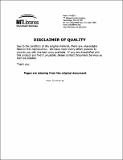Hydrogen degradation and microstructural effects of the near-threshold fatigue resistance of pressure vessel steels
Author(s)
Fuquen-Molano, Rosendo
DownloadFull printable version (8.491Mb)
Other Contributors
Massachusetts Institute of Technology. Dept. of Materials Science and Engineering.
Advisor
Robert O. Ritchie.
Terms of use
Metadata
Show full item recordAbstract
Safety of pressure vessels for applications such as coal conversion reactors requires understanding of the mechanism of environmentally-induced crack propagation and the mechanism by which process-induced microstructures as in thick section weldments affect the fatigue resistance of the structure. At low stress intensities near-threshold [delta]K₀ ([delta]K = Kmax - Kmin), water vapor in the environment was found to produce a pronounced effect on the fatigue resistance for partial pressures as low as 10 torr. In 2 1/4Cr-1%Mo SA378-2-22 steel the crack propagation rates at high load ratio (R = Kmin-Kmax) are increased in the presence of water vapor and the opposite effect is observed at low load ratio. It is proposed that water vapor-containing environments give rise to two mechanisms affecting crack growth rates: embrittlement caused by hydrogen produced in the water-metal reaction; and crack closure, enhanced by the increased surface roughness and the wedging action of the oxidation product. The microstructure is proposed to affect crack propagation rates mainly through crack closure induced by the synergistic effect of fracture surface roughness and oxide produced by fretting.
Description
Thesis (Ph. D.)--Massachusetts Institute of Technology, Dept. of Materials Science and Engineering, 1982. Includes bibliographical references (leaves 192-200).
Date issued
1982Department
Massachusetts Institute of Technology. Department of Materials Science and EngineeringPublisher
Massachusetts Institute of Technology
Keywords
Materials Science and Engineering.